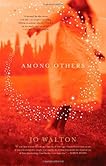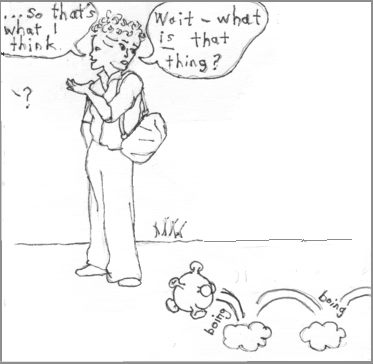The masses demanded, so they got. Well, one mass anyway. At first, it was looking like I wasn't going to get any material. The articles were all reasonably intelligent, or at least not outwardly idiotic. I turned to the Style section, which can usually be counted on to serve up something stupid. It's the Style section; isn't that what it's for? There's Chris Nuttal-Smith, right on the third page. I remember the time some guy wrote in to say he liked top hats and wanted to bring them back into fashion. Naturally Chris had to nip this kind of dangerous fashion dissension in the bud, so he got out the big guns (I picture an haute couture gun, perhaps with feathers hanging from it, unless they're not in fashion this year) and informed the reader that HE was not someone who could bring back the top hat and he'd better not even think of wearing one in public unless he wanted to make a fool of himself.
Of course not. A lowly citizen can't bring back the top hat. You need someone like Karl Lagerfeld, someone who already has a design house and is respected in the field. If Lagerfeld put on a top hat on one of his models, it would be heralded as revolutionary, everybody would be wearing one, and then the reader would be permitted his top hat. But put on a top hat when Lagerfeld hasn't done it yet, and you're just an ass.
Not being a fashion victim, I thought that was pretty stupid, and I expected to enjoy more, similarly stupid pronouncements. But this time, Chris was tackling the question of middle-aged people wearing clothes meant for young people. He nixed it, of course. "Cheap casual clothes are simply not flattering on imperfect men: This is why tailored suits are one's greatest support in old age. The same principle is true for women," he argues, and... I agree with him.* Apparently, if I wanted stylish stupidity, I'd have to dig deeper.
So I did, but page after page, I wasn't finding stupidity. Some perfectly credible furniture, a recipe, a piece about wines: all reasonable stuff. Hideous clothing on the two-page spread for Paris Fashion Week, but that's visual. I needed stupidity in print.
Just when I thought all was lost, I found it. Page 18. Katrina Onstad's column, entitled: Swedish for emasculated baby-men. First sentence:
It has been said that there is no greater test of a relationship than navigating the life-altering choice between a Krunst and a Gertllos throw rug.
And we have a winner. Thank you, Katrina Onstad! You have maintained G&M's vital stupidity quotient. Hear that, everybody? No greater test of relationships than shopping for a throw rug, so forget degenerative diseases and child rearing; they're insignificant.
OK, you could argue that she was being tongue in cheek, but I'm not so sure. The scary thing about the Globe and Mail is the peek it gives into this alien world of Toronto upper-middle classness where things that nobody else gives a shit about, like where to go to eat weird extruded, foam-covered nouvelle cuisine or which thousand-dollar handbag to buy, acquire a quasi-mystical, fetishistic significance. If you are the kind of person who cares about such things, then maybe throw-rug shopping really is the greatest relationship challenge you expect to face.
But perhaps I should get to the point. Katrina was very upset because IKEA had the temerity to try to rescue men from the pain of shopping. In a location in Sydney, Australia, they have installed Manland, a room that men can hang out in while they wait for their wives to finish shopping. It is said to contain entertainments such as foosball and hot dogs. As a Torontonian with no real problems, Katrina is deeply offended by this proposal.
"The set of assumptions behind Manland doesn't flatter either sex," she claims. "Once again, here comes the baby-man meme, wherein men are unable and unwilling to participate in the rote side of domestic life." Leaving aside the implication that all ideas are now "memes," whether or not they originated on the Internet, isn't it interesting that women are the ones who get to decide what constitutes "participation in domestic life"? One could argue that women don't adequately participate in the garbage-removal and snow-shovelling side of domestic life. Once they've been together a year or two, couples invariably and naturally split up tasks according to the inclinations and abilities of each spouse. Somehow that's never a problem until some woman says it is. I never heard a man say that a woman's not pulling her weight in the coupledom arena unless she's walked alongside him while he pushed the lawnmower, so it's not clear to me why men should have to shop with their wives if they find it a genuinely painful experience.
And they do. I can't count the number of times I've been in a store and seen a man sitting in a chair outside the women's changing room with a dead look in his eyes. One glance, and I know he's gone well beyond boredom. He hit boredom after the first half-hour. Now his brain has shut down. Ladies, if you love your man, why would you want to put him through this?
Mind you, that's clothes shopping. I think furniture shopping probably induces a fair bit of male unhappiness as well, but at least a sofa doesn't have to be tried on. If any store needs a Manland, it's a clothing store. Still, IKEA is to be commended for its innovation, and clothing stores may well follow suit.
There's more to Katrina's argument. "To be a man..." she claims, "is to participate fully in your relationship and muster up a civil opinion on a bath mat from time to time. Manland is a country populated by the lowest forms of manhood: the whiner who can't even put aside his own (adolescent) proclivities for an hour to help his wife carry a Shrompfken - one that he's probably going to enjoy sleeping on himself." In other words, a woman can't manage the shopping-at-IKEA task herself because there are two things she needs from her man: an opinion and help carrying things.
All right, I can accept that a woman might value her husband's input while shopping... for real furniture. You know, something major, like a dining room table or a sofa. Not a bath mat. A BATH MAT, Katrina? Are you kidding me? You need your husband's opinion on a bath mat?
I can't imagine why you would care about something so insignificant as which precise bath mat your spouse decided to bring home, unless you're a middle-class Torontonian, in which case I suppose it's a matter of crucial importance.
But yes, for larger purchases, your spouse's input might be desirable. Fine, but you need to be aware that compromise is a two-way street. That is, it means something other than what Katrina seems to think it means: Man does everything woman tells him to do. Compromise may mean, for example, that the woman moves through IKEA and makes purchasing decisions more quickly than she would like to. Contrary to popular belief, men are quite capable of shopping... at their pace. They know what they want, they go in, they get it, they leave. Done. What makes men miserable is the lingering that women like to indulge in.
As for the Shrompfken-carrying business, Manland is still in the store, meaning the man is still available to do whatever carrying is required. You only need to carry from the store to the car or bus. While you're in the store, you have the cart.
Katrina further claims, I can't help but suspect dishonestly, that women are being altruistic when they shop: "Perhaps there are those whose perfect Saturday includes Swedish meatballs and picture frames, but I suspect that almost no one actually wants to go to IKEA, regardless of gender." Really? That's news to me, because I love IKEA. I have ever since it was first introduced in Montreal. I loved the tyranny of the little maze you had to walk through when you went into the furniture section. There was a little gap you could squeeze through if you knew where it was, thereby skipping to the end, but to fully appreciate the IKEA experience was to walk the whole thing, seeing everything from living room sets to kitchens in the order that the designers intended. We have too much choice in our society, and studies have shown that that makes us unhappy. I appreciate the IKEA genius who took away not only our choice of where to wander but also rejected the alienating warehouse look of the average big box store in favour of a cozier, more human-sized maze. And you can even get Swedish meatballs at the end, in lieu of the traditional piece of cheese.
I'm not the only one either. I know that because Cristina Perissinotto once wrote a fabulous poem about how much she loves IKEA (I have no idea if she published it, unfortunately). [UPDATE (2011/11/16): Cristina herself has informed me that the IKEA poem can be read in her poetry collection Exhale, Exhale by Guernica Editions. Buy a copy at Book Depository and get free shipping.]
Angry as she is, Katrina is not afraid to toss in thoroughly spurious arguments if she thinks it will win her her point. "I look forward to my pedicure room at Rona," she says sarcastically, but since when do men make their wives come to the hardware store with them?
The arguments just get more spurious as she goes on. A few tweaks, and suddenly this is some sort of feminist, political issue. Comparing Manland to the newly-popular man caves, she decides that these phenomena mean that men are feeling "elbowed aside," and having invented the problem, rushes to undermine it. All of a sudden, she's quoting statistics ("in 2010, less than 30 per cent of Canadian MPs were female"), after which she declares snidely, "it's a touch difficult to see 'invisibility' as a male issue."
Invisibility? Lack of female MPs? I thought we were talking about men shopping at IKEA.
Still, man caves are an interesting subject, one that hardly helps her argument. They may be partly about retreating from the world and indulging in entertainments such as XBox and foosball, but they're also about a man having a space that he can decorate precisely as he wants to (even Katrina admits as much, with her fleeting reference to "an electric guitar as wall art"). That implies that the rest of the house is the woman's domain, where she holds sway and decorates as she sees fit. It is difficult to reconcile such a vision with Katrina's assertion that women value the male opinion on decor, even on such items as the lowly bath mat. One might rather be tempted to conclude that there is truth in the stereotype that a woman wants a man's opinion on decor as long as it jibes with her own, all the while reserving the right to summarily dismiss deviating opinions. If this is what men are experiencing, no wonder they'd rather hang out at Manland, or in the man cave, than join their wives in the IKEA maze. I suspect that Katrina—poor, furious Katrina—has no one to blame but herself.
* Actually, reading this statement over, I realize it merits mockery as well, for the claim that "tailored suits are one's greatest support in old age." Hello? What about walkers? Canes? Medicare? He would have done better to word that differently, but G&M columnists appear to be like Tinkerbell, unable to hold more than one thing in their heads at a time, and so the rest of the world is forgotten as they make wild overstatements to support their arguments pertaining to whatever trivial topic they happen to be discussing. Back

 I am pretty sure that this expression started out as "party hearty," with a t. But in North America, t's tend to be pronounced as d's, so that "party hearty" and "party hardy" sound the same. And in a society where sense is not expected, it doesn't matter that "party hearty" means "to party with gusto" and "party hardy" means, one can only suppose, "to party in difficult, inclement conditions." So when the expression got written down, "party hardy," whimsically nonsensical and having one letter fewer, won the day.
I am pretty sure that this expression started out as "party hearty," with a t. But in North America, t's tend to be pronounced as d's, so that "party hearty" and "party hardy" sound the same. And in a society where sense is not expected, it doesn't matter that "party hearty" means "to party with gusto" and "party hardy" means, one can only suppose, "to party in difficult, inclement conditions." So when the expression got written down, "party hardy," whimsically nonsensical and having one letter fewer, won the day.
 Global News did this. "The eyes of the world are literally on Iran," the broadcaster said. No, the eyes of the world are figuratively on Iran.
Global News did this. "The eyes of the world are literally on Iran," the broadcaster said. No, the eyes of the world are figuratively on Iran.
 If worse comes to worst. That's the expression, OK people? Really, a better expression would be, "if bad comes to worse." Maybe that's what the expression used to be, and people didn't think that was strong enough. But at least, "if worse comes to worst" makes some kind of sense. Things got worse, and then they got as bad as they possibly could—the worst. "Worst comes to worst," on the other hand, makes no sense at all.
If worse comes to worst. That's the expression, OK people? Really, a better expression would be, "if bad comes to worse." Maybe that's what the expression used to be, and people didn't think that was strong enough. But at least, "if worse comes to worst" makes some kind of sense. Things got worse, and then they got as bad as they possibly could—the worst. "Worst comes to worst," on the other hand, makes no sense at all.
 Another thing! You've got a thing coming. I love that. It's so idiotic, it's good. And no less an intellectual than Susie Bright used this expression (in her article about Camille Paglia: "If you think Pat Buchanan calls up Hurricane Camille for strategy sessions, you've got another thing coming"
Another thing! You've got a thing coming. I love that. It's so idiotic, it's good. And no less an intellectual than Susie Bright used this expression (in her article about Camille Paglia: "If you think Pat Buchanan calls up Hurricane Camille for strategy sessions, you've got another thing coming"